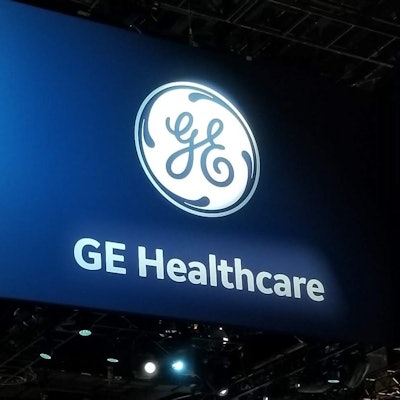
GE Healthcare is demonstrating a slate of new imaging technologies at this week's virtual RSNA 2020 meeting, including the latest version of its interventional imaging platform, a new 3D mobile C-arm, and an array of products enhanced with artificial intelligence (AI).
Interventional
Allia IGS 7 is a new version of the company's image-guided therapy platform that has been completely redesigned. GE enhanced the system's ergonomics and ease of use to improve workflow and efficiency.
Allia IGS 7 features a user interface that can launch essential functions with the push of one button, according to the company, and functions can be customized to the user. The system's C-arm has also been redesigned to make controls more accessible, and Allia IGS 7 includes an assistant that supports the most ergonomic setup depending on the clinical procedure.
The system is based on GE's AutoRight imaging chain for interventional x-ray systems, which is based on artificial intelligence and is designed to help users automatically acquire the right image at the right dose. The technique also includes a color-coded graphical display of real-time dose rates to help users optimize dose.
On the mobile side, OEC 3D is a new mobile C-arm designed to provide 2D and 3D images in a large field-of-view for surgeons. The system is designed to integrate easily into existing surgical workflows, and it sports a 3D reconstruction engine that gives users high-resolution volume-reconstructed images that approach CT in quality.
OEC 3D is pending 510(k) clearance from the U.S. Food and Drug Administration (FDA).
CT
In the CT section of its virtual booth, GE is talking up the photon-counting CT technology the company will gain access to with its proposed acquisition of Prismatic Sensors of Sweden, announced earlier in November. Prismatic Sensors has developed a novel method for positioning silicon sensors "edge on," so the detector can absorb very high-energy photons and is fast enough to count and quantify energies of hundreds of millions of CT photons each second.
When the photon-counting technology is fully developed, GE believes it has the potential to expand CT's clinical potential by revealing minute details of organ structures, better characterization of tissue, lower radiation dose, and more accurate measurement and quantification of material density. GE expects the deal to close in January 2021.
When the COVID-19 pandemic struck, GE responded with its CT in a Box offering, a portable package that offers a CT scanner and necessary equipment and supplies to enable pop-up imaging centers and hospitals to begin using CT quickly. GE has installed over 100 CT in a Box scanners worldwide.
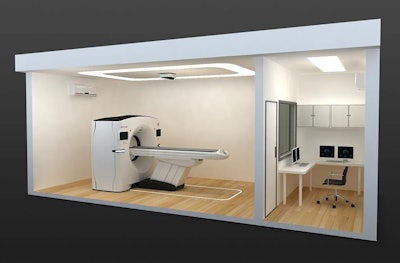 GE's CT in a Box concept is designed to help pop-up centers start scanning COVID-19 patients quickly. All images courtesy of GE Healthcare.
GE's CT in a Box concept is designed to help pop-up centers start scanning COVID-19 patients quickly. All images courtesy of GE Healthcare.The company is also discussing TrueFidelity for GSI, a reconstruction engine for CT images acquired using the company's Gemstone spectral imaging (GSI) technology. TrueFidelity has the potential to enhance conventional GSI images, delivering lower image noise, better contrast-to-noise ratio, and low contrast detectability. TrueFidelity for GSI, which is pending 510(k) clearance, also has the potential to improve lesion detection and characterization, as well as artifact reduction.
Finally, GE is discussing updates to its portfolio of CT applications for various clinical conditions. The company has updated its Thoracic VCAR application to allow users to make quantitative measurements of the lungs, while the company's FastStroke application to expedite stroke workup recently received 510(k) clearance.
MRI
A major highlight in the MRI section of GE's booth is Signa 7.0T, the 7-tesla scanner for which GE received FDA clearance in October. The scanner features GE's UltraG gradient technology, a whole-body gradient coil designed to support ultrahigh-field imaging and applications such as advanced diffusion and functional brain imaging, as well as musculoskeletal imaging of the knee and cartilage.
Software for Signa 7.0T will be based on the same platform as the company's 3-tesla family, including Signa Premier. The company believes this will facilitate the translation of advanced clinical applications from 7-tesla to 3-tesla more easily. The scanner also includes the company's SignaWorks software platform, which includes clinical applications.
Another major MRI highlight in GE's booth is the company's AIR family of products, which include flexible radiofrequency (RF) coils and software. AIR Recon DL is an image reconstruction algorithm based on deep learning that delivers shorter scan times with improved image quality in a variety of clinical indications, according to the company.
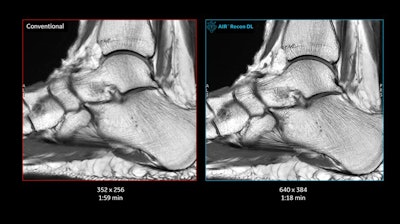 Ankle images with conventional MR reconstruction (left) and GE's AIR Recon DL reconstruction (right).
Ankle images with conventional MR reconstruction (left) and GE's AIR Recon DL reconstruction (right).GE is touting the use of AIR Recon DL for managing COVID-19 patients by saving on scanning time that can then be used to disinfect the scanner. Hospital for Special Surgery in New York City, an early user of AIR Recon DL, is reporting a reduction of 30% to 50% in exam times with the technology, with higher signal-to-noise ratio and better resolution. AIR Recon DL is available on all GE 1.5-tesla and 3-tesla scanners and has FDA clearance.
AIR x Knee is joining GE's AIR x family of workflow tools as a deep learning-based automated slice positioning application designed to reduce manual steps in setting up knee MRI scans. The application has been trained on over 200,000 knee images and multiple knee coils. AIR x Knee is included as part of the company's SignaWorks AIR IQ Edition software release.
GE has also added new offerings to its portfolio of AIR RF coils, which are now available on both 1.5-tesla and 3-tesla scanners. The company has now released two sizes of smaller multipurpose coils that are designed to provide added versatility and improve patient comfort.
In other MRI highlights, GE is touting ProView DL, a reporting and scoring tool for prostate MR scans that conforms to PI-RADS version 2.1 standards, providing automated segmentation of the prostate. Liver MultiScan is a noninvasive technology for evaluating liver disease that GE has accessed through a joint marketing agreement with Perspectum. The multiparametric MRI technique uses dynamic contrast to help radiologists see more detail when quantifying liver tissue.
Ultrasound
New clinical tools on its flagship Logiq E10 scanner are being highlighted in the ultrasound section of GE's booth. The company is discussing the system's cSound architecture for acquiring and reconstructing data with higher throughput and more processing power compared to previous GE systems.
One new clinical tool is ultrasound-guided attenuation parameter (UGAP), which quantifies liver steatosis to help in the early identification of patients with liver diseases. GE is also discussing new technology that provides a near-3D look for improving the visualization of small vessels and vascular patterns in masses.
Ultrasound has proved its value for imaging COVID-19 patients, and GE is discussing a range of ultrasound-based technologies for this application. A photo assistant app lets users take photographs of relevant anatomy and include them with clinical images for context and documentation. Live remote training sessions are also possible with the company's Digital Expert technology, and GE is pointing out how Logiq E10 is designed for easy disinfection.
GE is also discussing the Vivid E95 premium 4D cardiovascular ultrasound scanner, which is sporting new AI-based features for acquiring more repeatable exams through tools like semiautomatic measurement of spectral Doppler images. And Voluson Swift is a new women's ultrasound scanner with embedded AI that makes possible applications like SonoLyst, which recognized 20 views recommended by the International Society of Ultrasound in Obstetrics and Gynecology midtrimester practice guidelines for fetal imaging.
Finally, Venue Go is the newest member of GE's Venue family of point-of-care ultrasound scanners. It also includes AI tools and can be used to detect conditions related to COVID-19.
Women's imaging
Senographe Pristina Gen II is the second generation of GE's Pristina mammography platform, and it includes new features designed to improve workflow by reducing repetitive tasks, such as patient autopositioning and enhanced image archiving. GE believes the enhancements can produce time savings of one hour per month for each system used.
Serena Bright is a new contrast-enhanced guided biopsy technology that allows these exams to be performed on the same mammography equipment, rather than requiring patients to be transferred to a breast MRI scanner.
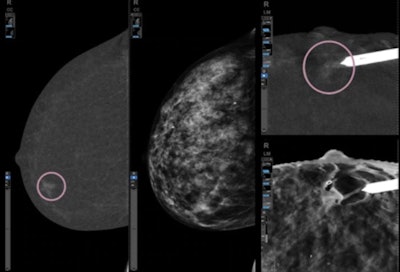 GE's Serena Bright software can assist in breast interventions, as in the case of this clip deployment.
GE's Serena Bright software can assist in breast interventions, as in the case of this clip deployment.Serena Bright is based on the company's SenoBright HD contrast-enhanced spectral mammography (CESM) technology, which highlights unusual blood flow patterns and can be performed after an inconclusive mammogram or ultrasound exam. SenoBright HD is offered as an option on Pristina.
GE is also discussing the ProFound algorithm from iCAD for detecting malignant soft-tissue densities and calcifications, providing a numerical confidence score on whether a case is malignant.
Radiography
In radiography, GE is announcing a new AI algorithm in its Critical Care Suite 2.0 family that's designed to help clinicians with the placement of endotracheal tubes (ETTs) -- a procedure that's sometimes needed when putting COVID-19 patients on ventilators.
Designed for use with GE's mobile x-ray system, the algorithm is intended to prevent complications that may occur when patients have misplaced ETTs, a condition that can be detected on chest x-rays. Critical Care Suite 2.0 uses AI in chest x-rays and gives automated measurement of ETT positioning to clinicians just seconds after images are acquired.
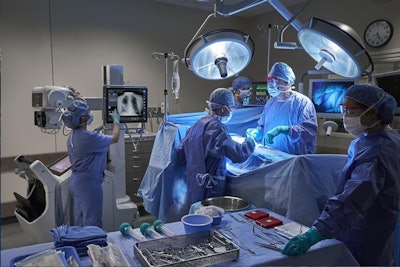 GE's Critical Care Suite software consists of AI-powered applications that can be used in the operating room.
GE's Critical Care Suite software consists of AI-powered applications that can be used in the operating room.Thoracic Care Suite is a group of eight AI algorithms from GE partner Lunit's Lunit Insight CXR product line that analyzes chest x-rays and flags abnormalities -- including those related to COVID-19 -- that could require further radiologist review.
New features on the Definium 656 HD radiography system include livestreaming video of patients thanks to a camera mounted on the system's tube head, as well as embedded Critical Care Suite algorithms that can automatically flag cases of pneumothorax for faster radiologist review.
Molecular imaging
Highlights in molecular imaging in GE's virtual booth at RSNA 2020 include Discovery MI Gen 2, the newest addition to the company's PET/CT family. The company is highlighting the use of deep learning-based reconstruction for images acquired with the system, generating what GE calls TrueFidelity CT images.
Other features on Discovery MI Gen 2 include its LightBurst digital detector, with an axial field-of-view of up to 30 cm and a 60% increase in the system's noise-equivalent counting rate, which can be leveraged for either a 50% reduction in scan time or in radiopharmaceutical dose.
GE is also demonstrating its medium-energy high resolution and sensitivity (MEHRS) collimator for its cadmium zinc telluride (CZT) general purpose SPECT/CT systems, such as the NM/CT 870 CZT system. MEHRS is optimized for imaging indium-111, lutetium-177, and gallium-67 radiopharmaceuticals.



















